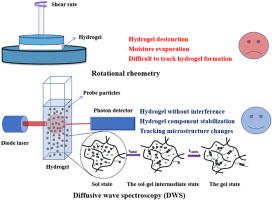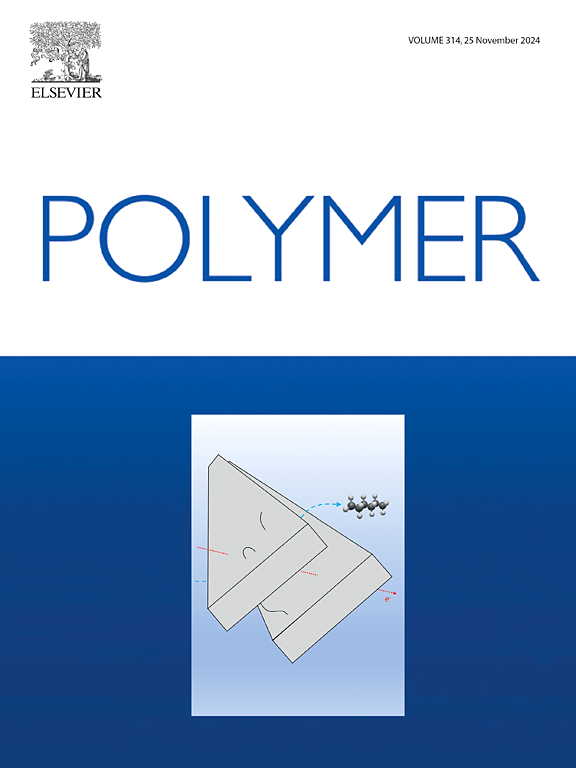用扩散波谱法研究壳聚糖-戊二醛水凝胶凝胶化过程的 pH 依赖性
IF 4.1
2区 化学
Q2 POLYMER SCIENCE
引用次数: 0
摘要
功能性水凝胶的凝胶时间是决定其在各种应用中的实用性的一个基本特性。为了准确评估这一参数,我们使用两种互补的分析工具--旋转流变仪和扩散波谱仪(DWS)对壳聚糖-戊二醛水凝胶进行了表征。旋转流变仪被广泛用于连续监测水凝胶在凝胶化过程中的宏观力学性能。通过观察模量变化曲线,可以深入了解凝胶网络内部发生的瞬时变化。这种方法可直接测量凝胶的机械强度,但需要对样品施加外力,可能会造成测量滞后和样品变形或破坏等假象。研究结果表明,在旋转流变仪测量过程中施加外力会破坏凝胶化过程。相比之下,DWS 可通过测量光扩散来检测微观结构的变化,从而跟踪交联和固化后的微观结构变化,而不受外部应力的干扰。因此,DWS 提供了一种研究凝胶化的非侵入性方法,因为它通过监测光的衍射来检测水凝胶中颗粒的布朗运动,从而提供有关凝胶行为的不受干扰的动态信息。DWS 技术尤其适用于跟踪水凝胶交联和固化过程中发生的微观结构变化,而不会改变凝胶的原生状态。DWS 的另一个优点是能够研究 pH 值对凝胶化的影响。通过测量凝胶化时间随 pH 值的变化,我们可以实现对凝胶化过程的精确控制。这种对凝胶化动力学的微调对于需要快速或延迟凝胶化的应用至关重要,其精确度是传统流变学方法难以企及的。本文章由计算机程序翻译,如有差异,请以英文原文为准。

Investigating the pH-Dependence of Gelation process in Chitosan-glutaraldehyde Hydrogels with Diffusing Wave Spectroscopy
The gel time of functional hydrogels is an essential property that dictates their utility in various applications. To accurately assess this parameter, the chitosan-glutaraldehyde hydrogels were characterized here using two complementary analytical tools, rotational rheometer, and diffusing wave spectrometer (DWS). Rotational rheometers are widely used to continuously monitor the macro-mechanical properties of hydrogels during the gelation process. By observing the modulus change curve, one can gain insights into the instantaneous changes occurring within the gel network. This method provides a direct measurement of the gel's mechanical strength; however, it involves applying external forces to the sample, which may introduce artifacts such as measurement lag and potential sample deformation or destruction. Results of this study indicated that the application of external force during rotary rheometer measurements disrupted the gelation process. In contrast, DWS detected alterations in the microstructure by measuring light diffusion, allowing to track microstructural changes post-crosslinking, and curing without the interference of external stress. Thus, DWS offers a non-invasive approach to studying gelation as it detected the Brownian motion of particles within the hydrogel by monitoring the diffraction of light, thereby providing undisturbed dynamic information about the gel's behavior. The DWS technique is particularly useful for tracking microstructural changes that occur during hydrogel crosslinking and curing, without altering the gel's native state. An additional advantage of DWS is its ability to investigate the pH effect on gelation. By measuring changes in gelation time as a function of pH, we could achieve precise control over the gelation process. This fine-tuning of gelation kinetics is crucial for applications that require rapid or delayed gelation, offering a level of precision that is difficult to match with traditional rheological methods.
求助全文
通过发布文献求助,成功后即可免费获取论文全文。
去求助
来源期刊

Polymer
化学-高分子科学
CiteScore
7.90
自引率
8.70%
发文量
959
审稿时长
32 days
期刊介绍:
Polymer is an interdisciplinary journal dedicated to publishing innovative and significant advances in Polymer Physics, Chemistry and Technology. We welcome submissions on polymer hybrids, nanocomposites, characterisation and self-assembly. Polymer also publishes work on the technological application of polymers in energy and optoelectronics.
The main scope is covered but not limited to the following core areas:
Polymer Materials
Nanocomposites and hybrid nanomaterials
Polymer blends, films, fibres, networks and porous materials
Physical Characterization
Characterisation, modelling and simulation* of molecular and materials properties in bulk, solution, and thin films
Polymer Engineering
Advanced multiscale processing methods
Polymer Synthesis, Modification and Self-assembly
Including designer polymer architectures, mechanisms and kinetics, and supramolecular polymerization
Technological Applications
Polymers for energy generation and storage
Polymer membranes for separation technology
Polymers for opto- and microelectronics.
 求助内容:
求助内容: 应助结果提醒方式:
应助结果提醒方式:


